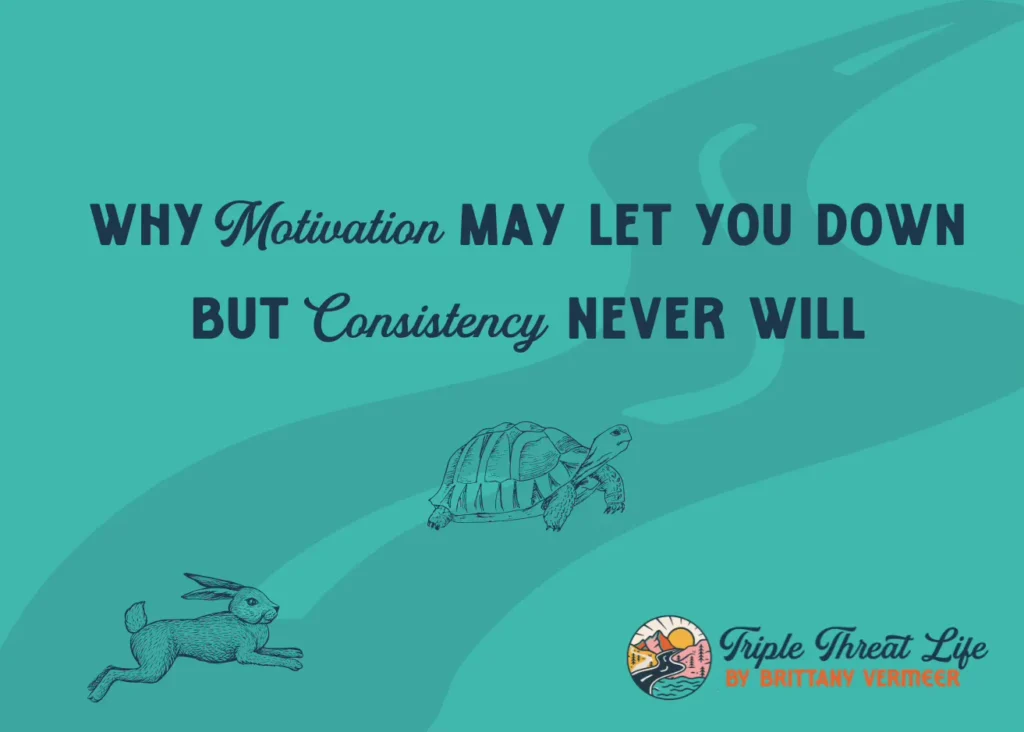
Let’s go back to your childhood to that beloved Aesop’s fable, The Tortoise and the Hare.
You know the one. It features an overconfident, braggadocios bunny and a humble, patient tortoise.
A Hare was making fun of the Tortoise one day for being so slow.
“Do you ever get anywhere?” he asked with a mocking laugh.
“Yes,” replied the Tortoise, “and I get there sooner than you think. I’ll run you a race and prove it.”
As the story goes, the speedy hare mocks the tortoise for his slow and plodding pace. But the tortoise is confident and says they should run a race.
The hare accepts the challenge and is soon out of sight. To illustrate his point about being the faster of the two, he lies down to take a nap.
But the tortoise continues on at his steady pace and eventually overtakes the sleeping rabbit. By the time the hare wakes up, the tortoise is only steps away from the finish line.
Moral of the story: Slow and steady wins the race.
This is just one of many lessons in this short tale, but as athletes we often reject this idea. Why?
Because we see that, in reality, slow and steady does not in fact win races. Getting from point A to point B the fastest is what wins race.
But when we think this way, we’re entirely missing the point.
What the tortoise and the hare actually represent is the difference between motivation and consistency.
What is motivation?
Simply put, motivation is why a person does something. It’s the driving force behind our actions.
Motivation is the reason you pick a certain major in college, decide to lose weight, start your own business, or sign up for a triathlon.
We all want to feel motivated. Motivation is like a shot of adrenaline or a cup of coffee. It makes us feel like we can kick butt, take names, and conquer the world, all before lunchtime.
But just like caffeine, motivation eventually wears off… and it doesn’t have a great half-life.
Now that doesn’t mean motivation is necessarily bad. Motivation is important because it provides us with a driving force- our why.
But you can’t rely on motivation alone. Why?
Motivation is fickle. It comes and goes. Motivation changes based on our mood and emotions. Relying solely on motivation is not a sustainable long-term strategy for achieving success.
But if motivation is the prom queen, then consistency is the nerdy girl in glasses who’s going to be a millionaire someday.
What is consistency?
Consistency is the methodical, sustained, and disciplined effort that’s put it over time in order to achieve a set goal.
Consistency is about dedication, discipline, and determination. In order to be consistent, you need to engage in a repeatable action on a regular basis. It doesn’t necessarily have to be every day, as long as it’s executed on some type of schedule.
Practically, this might look like swimming on your lunch break every Monday, Wednesday, and Friday or meal-prepping every Sunday afternoon.
Consistency isn’t flashy. It’s simply about putting in the work on a regular basis, until over time, it becomes a habit.
When you’re consistent in your actions, that’s when the real magic happens.
“We are what we repeatedly do. Excellence, then, is not an act, but a habit.”
– Will Durant (not Aristotle)
I heard a funny story recently. When a kid wasn’t feeling motivated to do something, like schoolwork, he would tell his teacher, “I don’t want to do it!” To which, the teacher would reply, “Then, you will do so without wanting.”
Trust me, during Ironman training there are definitely times when Matt and I don’t really want to wake up early to do a hard bike ride before work, or do a crazy long run on a Saturday.
But consistency isn’t about desire. (That’s motivation.) Consistency is solely about execution.
While motivation is the spark that causes initial action (signing up for a race, committing to eating healthy, going to the gym, ect.) consistency is what will help you achieve your goal, especially on those days when your motivate wanes.
I saw a video recently where someone talked about how the actual Ironman isn’t accomplished during the race itself. It’s in the training- the day in and day out choices we make to get up and do the work, even when we’re tired and don’t feel like it.
Think about it this way. Motivation is short bursts of energy, like V02 max intervals or sprints, and consistency is your zone 2, long run. You need both to be a successful runner, and you need both to accomplish pretty much any goal in life.
Simply by being more consistent we can:
- be more productive
- have better focus
- build better habits
- achieve long term goals
- lessen the fear of failure
- prevent burnout
Why motivation may let you down, but consistency never will
Let’s paint a picture. A triathlete signs up for a 70.3 or an Ironman. At the onset, motivation is high. After all, that’s why he pushed the (register now) button. All his friends are going. We’ll train together, they said. It will be a blast, they said…
Flash forward to 4 months down the road when he starts complaining about not feeling motivated to get in the pool to do his swim workouts. He doesn’t feel motivatedto do the brick he’s supposed to, so he cuts it short.
In this case, motivation isn’t the problem. Consistency is.
He’s making the same mistake that so many athletes make. We confuse motivation (feeling and emotion) with consistency (repeated action)- putting forth the daily and weekly effort that keeps us on track in pursuit of our goal.
In this way, the tortoise knew what the hare did not.
While motivation gets you started, consistency is what keeps you going. It ensures steady progress, even during times of low motivation. You just need to keep showing up.
“Thus plain plodding people, we often shall find, Will leave hasty confident people behind.”- Jeffreys Taylor
So for today’s deeper dive into this topic, Triple Threat Life club members will learn:
- The difference between intrinsic and extrinsic motivation.
- The 9 motivation sub-categories.
- How to determine which type of motivation will work best for you.
- 5 proven strategies to develop consistency.
Different Types of Motivation
Motivation isn’t one-size fits all. It varies by individual.
Although two people might do the same activity, their motivation can be completely different. In this way, you can pursue the same objective as someone else, but for an entirely different reason.
For example, two friends sign up for an Ironman triathlon. One is motivated by a love of pushing personal boundaries and finding her limits. She wants to conquer this epic challenge to prove to herself that she’s strong, capable, and can do hard things even when it’s scary.
The other is motivated because he wants the title of being an “Ironman.” He wants to get the leg tattoo, receive his finishers medal, and hear the announcer call his name as he runs down the red carpet.
Same goal. Two different motivations.
Let’s look at two different types of motivation.
- Extrinsic
- Intrinsic
Extrinsic motivation comes from an outside source. You feel compelled to do something because of outside factors that exert their influence, like friends, family, advertising, social pressure, ect. Extrinsic motivation might come in the form of awards and results or even negative consequences.
Intrinsic motivation comes from within. You do something because it aligns with your personal values, interests, and passions. This type of motivation is internal. You feel a deeper purpose for doing something.
Within intrinsic motivation, there are a few different types:
- Learning- You enjoy learning new skills and achieving things you haven’t tried yet.
- Attitude- You like being positive, spreading joy, and making others feel good.
- Achievement- You enjoy the feeling of accomplishment, not necessarily the reward or results.
- Creative- You enjoy creating.
- Physiological- You’re motivated by biological needs, like food or water.
There are a few different types of external motivation as well:
- Incentive- You’re motivated by the outcome more than the act. You look forward to results, prizes, or awards.
- Fear- You’re motivated by something you don’t want to happen.
- Power- You want to exert your influence on other people.
- Social- You’re motivated by what others think of you. You want to be accepted and for people to like you.
By now, you probably have a good idea of where you fall on the spectrum of internal vs. external motivation. So how can you use this knowledge to your advantage?
If you’re motivated by personal achievement, consider setting process and outcome goals that will help you stay focused and maintain a clear purpose.
Read Process vs. Outcome Goals: Which is Best?
If you’re motivated by incentives, create a system to reward yourself for small wins. For example, if you complete all your workouts for the week, you get a small treat. Or use an app that tracks mileage or tasks and provides a gamification aspect with virtual rewards.
If you’re socially motivated, use accountability to help you stay motivated. Tell others about your goals. Also, working out with other people can do wonders to ensure that you keep showing up and stay on track.
If you’re physiologically motivated, focus on nutrition and hydration tracking to make sure that you’re getting enough protein, carbohydrates, and electrolytes to fuel your workouts. Also, track your fitness improvements and focus on the ways your training is helping you become more healthy.
If you’re motivated by learning, read books by fitness authors, listen to podcasts, and watch YouTube videos to practice new skills and hone your technique.
Basically, determine which type of motivation suits you best and then use it to your advantage.
Proven habits to develop consistency
We now know that motivation is only one part of the equation. We also need to be consistent.
That’s easier said than done. Here are a few proven strategies to develop consistency.
1. Become a prep-master- The key to being consistent is making it easy to be consistent. Anything you can do to prep ahead of time not only makes you more efficient and streamlines the process; it ensures that you won’t skip doing the actual activity because you’ve already dedicated time to preparation.
For example, we keep a bag with all our workout gear in one place: cycling shoes, helmet, heart rate strap, sunglasses. We do the same with our swim bags and gym bags. This makes it easy to grab and go.
Also, we meal-prep breakfasts and lunches on Sunday afternoon for the rest of the week. Breakfast: overnight oats with Greek yogurt, almond milk, granola, peanut butter, chocolate chips in individual mason jars. Lunches: protein (chicken, pork, chicken sausage) + rice + veggies.
Most of the time, we’re working out in the morning before work or on our lunch break. Anything we can do to plan ahead saves time and streamlines the process, making it easier to get our workouts in.
2. Create a schedule- Instead of waiting until the day of to decide how you’re going to fit a workout in, make a schedule for the entire week. For example, we swim at lunch on Wednesday and Friday. Then, we go to the gym after work. On Tuesday and Thursday, we do a brick workout (bike/run) in the morning before work.
Long rides and runs are on Saturday and Sunday. It doesn’t matter if we have a race on the calendar or not, we follow the same schedule each week. Making a schedule you can stick to will help you develop habits that are easier to sustain over time.
3. Set smart goals- Smart goals should be specific and measurable. Also, a goal must be clearly defined and have a time frame. A goal requires a detailed plan of action with steps to follow.
Here are a few examples of not-so-great-goals:
- I don’t want to be the slowest runner in my training group.
- I want to improve my bike split.
- I need to eat more healthy meals.
Here are better versions of those goals.
- Over the next 3 months, I will work on my running form and aerobic threshold to improve my X time from an X to an X.
- During the off-season, I will work to increase my FTP on the bike by doing X threshold-focused sessions and X strength sessions, X times a month.
- Over the next 4 months, I will commit to making a healthy dinner 3 times a week that incorporates protein, vegetables, and grains.
Click here to read- Give Your Goals a Makeover: 5 Tips For Setting Achievable Goals.
4. Start small- Becoming more consistent isn’t about making massive changes. Those are harder to sustain. Think about making a small change that you can stick with until it has time to develop into a habit.
This might be something as simple as getting up 30 minutes earlier each day to get a head start on work, or to give you more time to get your workout in.
If you’re a list person (I am) try writing down daily objectives you want to accomplish and check them off as you go.
5. Get an accountability partner- The value of working out with friends and training partners can’t be overstated. For those of us who are socially motivated, the time we spend training is almost as important as the race itself.
If you struggle with consistently getting to the pool to do your swim workouts, agree to meet up with a friend twice a week. If you don’t like doing long rides by yourself, hook up with a group that will motivate you and push you to become more consistent.


